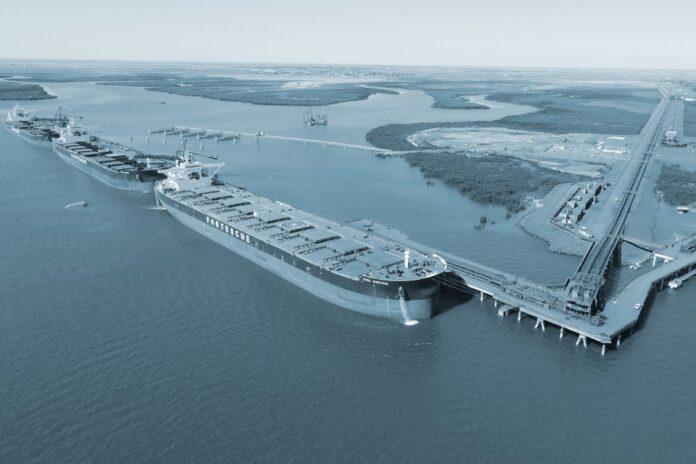
Volatility in the shipping markets could rebound due to fresh disruptions to economic activity. The road out of the pandemic suddenly seems blocked again, causing governments and businesses to apply further restrictions. By Michael Hollmann[ds_preview]
The road out of the pandemic suddenly seems blocked again as Omicron cases surge, causing governments and businesses to apply further restrictions in a bid to slow the spread of the new variant. Economic activity in the Eurozone slowed down in December as illustrated by a drop in the IHS purchasing manager index (composite) dropping from 55.4 in November to 53.4.
Growth momentum also subsided in the US, although not as much as in Europe, based on PMI data. Growth projections for Germany this year were already lowered but many in deepsea shipping are waiting for the next world economic outlook by the IMF at the end of January for fresh guidance on trade and cargo growth.
Concerns are running …
Generally, expectations both for container and for dry bulk shipping are positive due to modest fleet growth and higher forecasts for trade growth. However, developments in the supply/demand ratio may have to be reassessed to some extent following the rapid rise of Omicron. Concerns are running high as this issue of HANSA goes to press that the new variant, which vaccines are less effective against, will prompt more lockdowns and closures, both in the western world and in China and the rest of Asia.
Early reports that China’s Sinovac vaccine may offer little protection against Omicron is raising prospects of further large-scale factory and port closures in the country. The result would be further supply shortages across industry and commodity sectors with knock-on effects worldwide. »The risk of a major impact from Omicron spreading in China is indeed significant, and we could well be facing much more turbulence in the supply chain,« warned container shipping analyst Lars Jensen.
His words were echoed by experts in dry bulk shipping like London broker SSY cautioning against disruptions and further fleet inefficiencies going forward. Capacity utilisation is still very high especially in the container sector but a drop in export volumes due to early plant closures in China before Chinese New Year could begin to tip the market balance against carriers. The slight, though temporary cooling in cargo demand after Golden Week in October, partly driven by energy shortages across industry, might have been a foretaste. A soft landing in container shipping to lower levels, albeit high by historical standards, looks more likely than it did a few weeks back.
For bulk shipping, the largest risk this year is reduced raw materials demand from China’s steel sector. Fresh economic disruptions due to Omicron would only add to downward pressure from China’s construction and real-estate sector – the largest consumer of steels in the country.
China’s steel output falling further?
In December, China Metallurgical Industry Planning and Research Institute (MPI) projected another slowdown in steel consumption by 0.7 % to 947 mill. t this year, following last year’s contraction by an estimated 4.7 % to 954 mill. t. China’s iron ore imports – the main source of business for capesize bulk carriers – is likely to be impacted. The question is to what extent any decline in chartering demand can be counterbalanced by an increase in fleet inefficiencies?
Port closures, stricter quarantine provisions for ships and for crews are not a nice prospect as such but would serve to lengthen the vessel queues outside ore and coal ports in Asia. Tonnage availability would thus be contained and freight rates bolstered.
It was a different story in the final weeks of 2021, though, with congestion levels continuing to fall in dry bulk ports in China across all vessel classes, adding to pressure on freight rates. Spot earnings saw sharp corrections after a bit of see-sawing, first on capes and then on panamaxes, too, with levels in the Atlantic slipping first and the Pacific dropping in line. It is a familiar seasonal pattern every year just before Xmas and the usual first quarter lull in the bulk markets.
Handysize – last one standing!
The smaller geared segments performed more stable as they already did in the early months of the year. The result was an inversion in rates, with the 38,000 dwt handysize recording the highest time charter average at $ 28,000 on 16 December, followed by $ 27,649 for 58,000 dwt supramaxes. Capes came third at $ 24,000 and panamaxes last at $ 23,630. The outlook for smaller bulkers appears more favourable based on stronger demand projections for coal and minor bulks.
Although anything but desirable from an environmental perspective, the International Energy Agency (IEA) has warned that global coal demand could surge to an all-time high in 2022 and stay there for two years due to rampant demand from the power sector. Especially supramaxes with their reliance on the Indonesian coal trades stand to benefit.
Meanwhile in container shipping, the tonnage situation tightened again. Congestion on the US westcoast, in Singapore and Mediterranean hub ports coincided with another cargo rush ahead of Chinese New Year, lending strength to freight rates. The charter market became busier again, arresting the decline in short-term hire rates since October and pushing levels back up.
















